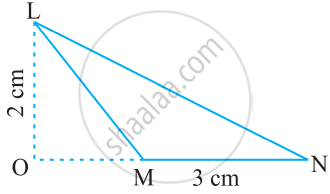Advertisements
Advertisements
प्रश्न
Show that the points are the vertices of an isosceles right triangle.
उत्तर
The given points are A (3, 0), B(6, 4) and C(-1, 3) Now,
`AB = sqrt((3-6)^2 +(0-4)^2 ) = sqrt((-3)^2 +(-4)^2)`
`= sqrt((9+16)) = sqrt(25) = 5`
`BC = sqrt((6+10)^2 +(4-3)^2 )= sqrt((7)^2+(1)^2)`
`=sqrt(49+1) = sqrt(50) = 5 sqrt(2)`
`AC = sqrt((3+1)^2 +(0-3)^2) = sqrt((4)^2 + (-3)^2)`
`= sqrt(16+9) = sqrt(25) =5`
`∵AB +AC and AB^2 +AC^2 = BC^2`
Therefore,A (3, 0), B(6, 4) and C(-1, 3) are die vertices of an isosceles right triangle
APPEARS IN
संबंधित प्रश्न
Find the values of k so that the area of the triangle with vertices (1, -1), (-4, 2k) and (-k, -5) is 24 sq. units.
Prove that the area of a triangle with vertices (t, t −2), (t + 2, t + 2) and (t + 3, t) is independent of t.
Find the area of the quadrilateral ABCD whose vertices are respectively A(1, 1), B(7, –3), C(12, 2) and D(7, 21).
In each of the following find the value of 'k', for which the points are collinear.
(7, -2), (5, 1), (3, -k)
If the coordinates of the mid-points of the sides of a triangle are (3, 4) (4, 6) and (5, 7), find its vertices.
Find the area of ΔABC whose vertices are:
A( 3,8) , B(-4,2) and C( 5, -1)
Show that ∆ ABC with vertices A (–2, 0), B (0, 2) and C (2, 0) is similar to ∆ DEF with vertices D (–4, 0), F (4, 0) and E (0, 4) ?
Find the area of the following triangle:

The points (1,1), (-2, 7) and (3, -3) are ______.
Find the missing value:
| Base | Height | Area of Triangle |
| ______ | 31.4 mm | 1256 mm2 |
